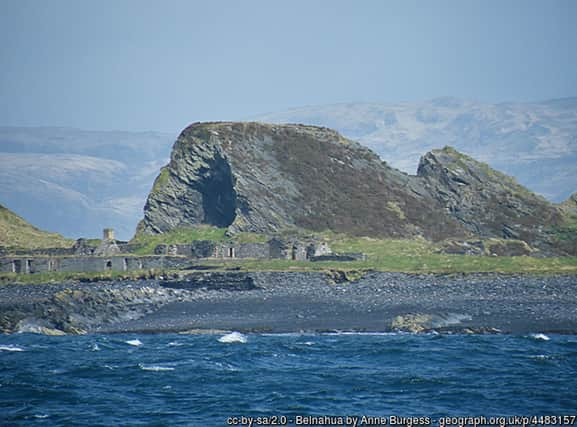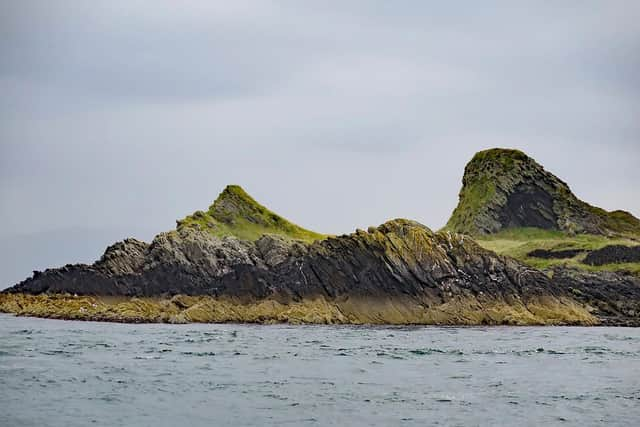The abandoned workers cottages of a Scottish 'ghost island'


Belnahua in the Firth of Lorn is one of Argyll’s ‘Slate Islands’ where slate was been mined since prehistoric times and then helped to roof the Empire from the late 18th Century with a global industry connecting this tiny place to hungry markets in England, Canada and the West Indies.
In 1790, the entire island was leased to help in the buiding of the new town of Oban.


Advertisement
Hide AdAdvertisement
Hide AdThe island sits further into the sea than its Slate Island neighbours, which include Luing, Seil and Easdale with production on some lasting until the 1960s.
But at Belnahua, a place where little grew and food arrived by boat, along with water when the well ran dry, life ceased in 1914 when all the island’s men went to war and women and children relocated to neighbouring isles.
Since then, the island has been reclaimed by nature, with abandoned pieces of industrial machinery and the deserted homes all that reveal Belnahua’s past, as does the deep pool of water that has taken over the former quarry.
An account of what life was like here was given in 1936 by Dougal Gillies who grew up on the island but who left in 1884 when the slate quarries were still prosperous and around 100 people called it home.
In 1936 on his return trip to his childhood home, Mr Gillies, then of Kirkintilloch, found the island completely barren – apart form the seagulls.
But the journey prompted memories of a wild and free childhood that included traditions of boy’s stamping meal in white stockings and the slaughter of an ox twice a year, a ritual which the whole island turned out to witness. Stopping to watch the lines of whales that swam past the island was another feature of island life.
He recalled how the owner of the quarry was known as “The King” who kept cows which supplied the whole island with milk.
Mr Gillies found the house where he was born had been knocked down in order to construct a sea defence. While most of the houses were just ruins, four of them remained in a good state, with the old schoolhouse still standing, albeit without windows.
The shell of the village store also remained.
Advertisement
Hide AdAdvertisement
Hide AdMr Gillies said: “It reminded me of a job the boy’s on the island used to get at the store. When a supply of meal was being taken in for the winter the little granary at the store was taxed to its utmost capacity, and all the available boys were asked in and given long white stockings to wear, after which they tramped down the meal.
He added: “Another event the island was the killing of an ox. Twice year my father would get an ox brought over from the mainland. The beast was usually slaughtered at the mouth of the cave, and the whole island turned out to watch.
“I remember that on these days it was impossible to teach the children anything in the school, because the school windows were in full view the cave, and the scholars could watch the ox being slaughtered. "
Mr Gllies said almost everyone spoke Gaelic on the island and that he could speak barely any English when he left Belnahua.
“Although were taught English in school, we forgot the words as soon our noses were outside the door,” he added.
A great storm of 1881 washed over the entire cluster of Slate Islands and remains one of the worst weather events in this part of the world of all time. On Belnahua, almost every house was flooded. Children were put up on the rafters for safety and some cows were washed away, but no lives were lost.
Belnahua was sold off when the Breadlebane estates were broken up in the 1930s.
In 1952, it was was reported that a Dr Dugald Richard Gillies left his two islands, Belnahua and Ormsa, to his daughter in his will, although it is not clear if it the same man who gave the account in 1936.
Advertisement
Hide AdAdvertisement
Hide AdA newspaper report in the Coventry Evening Telegraph, said: “The islands, south-west of Oban, were bought by Dr. Gillies some 20 years ago.”
Dr Gillies’ widow told the newspaper that her husband’s grandfather had once owned the island and that it was bought “for the sake of sentiment” when it was offered for sale.
Today, with is slate reserves used up and without any services to connect it to the wider world, it is unlikely that Belnahua will be inhabited once again.
But what remains is an intriguing window into the past life of this once-thriving industrial island, where peace now permanently falls.
A message from the Editor:Thank you for reading this story on our website. While I have your attention, I also have an important request to make of you.With the coronavirus lockdown having a major impact on many of our advertisers - and consequently the revenue we receive - we are more reliant than ever on you taking out a digital subscription.Subscribe to scotsman.com and enjoy unlimited access to Scottish news and information online and on our app. With a digital subscription, you can read more than 5 articles, see fewer ads, enjoy faster load times, and get access to exclusive newsletters and content. Visit https://www.scotsman.com/subscriptions now to sign up.
Our journalism costs money and we rely on advertising, print and digital revenues to help to support them. By supporting us, we are able to support you in providing trusted, fact-checked content for this website.
Joy Yates
Editorial Director